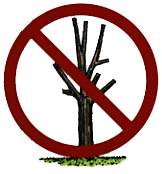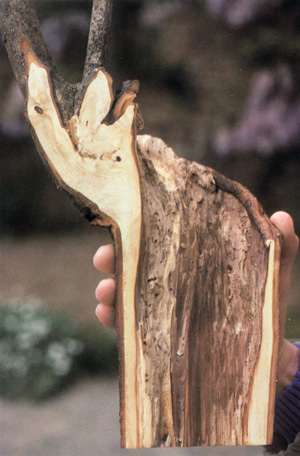Reasons to Stop Topping Trees
Despite the clear guidelines set out in Australian Standards - AS4373:1996 Pruning of Amenity Trees, topping (sometime referred to as lopping) is still practiced within our urban forests.
This misguided practice is a threat to the urban forest because it dramatically shortens the lifespan of trees and creates hazardous trees.
The importance of trees to the urban ecology is gradually becoming known and appreciated. This dawning has not yet been accompanied by adequate public education and sound public policy to ensure tree survival and our own safety.
DON'T TURN YOUR VALUABLE COMMUNITY ASSETS INTO LEGAL AND ECONOMIC LIABILITIES!

PLEASE READ AND CONSIDER THE FOLLOWING
IT WON'T WORK.
Topping won't keep trees small. After a tree is topped, its growth rate increases. New growth comes back rapidly in an attempt of survival. Trees need all their leaves so they can manufacture sugars for healthy growth. They won't slow down until they reach their mature size.
The species or type of tree you have determines its size. A Japanese maple may grow from 4 to 10 meters in its life whereas a gum might reach heights of 20 to 40 meters. You can't "stop" trees with topping. If you succeed, you have killed them.
IT'S EXPENSIVE.
A topped tree must be done and re-done every few years-and eventually must be removed when it it dies or the owner gives up. Each time a branch is cut, numerous long, skinny young shoots (called suckers or epicormic growth) grow rapidly back to replace it. They must be cut and recut, but they always regrow the next year making the job exponentially more difficult. A properly pruned tree requires far less maintenance, since proper pruning does not stimulate an upsurge of regrowth. Proper pruning actually improves the health and beauty of a tree, costing you less in the long run.
IT'S UGLY.
The sight of a topped tree is offensive to many people. The freshly sawed-off tree limbs are reminiscent of arm or leg amputations. And the freshly-sawed look is just the beginning of the eyesore; the worst is yet to come, as the tree regrows a witch's broom of unattractive, straight suckers.
The natural beauty of the tree's crown is a function of the uninterrupted taper from the trunk to ever finer and more delicate branches, and the regular division of the branches. Arborists consider the topping of some trees a criminal act, since a tree's 90-year achievement of natural beauty can be destroyed in a couple of hours.
Topping destroys the winter silhouette of a tree. Some trees will reestablish themselves after many years-but by then they will be the same size as before. Many topped trees are considered a total loss.
IT'S DANGEROUS.
According to Dr. Alex Shigo, world renowned scientist and author on the subject of arboriculture (trees), topping is the most serious injury you can inflict upon your tree. Severe topping and repeat topping can set up internal columns of decay, the ill effect of which may show up years later in conjunction with a drought or other stress.
Ironically, many people top their trees because they think it will make them safer. Topping creates hazardous trees. In Australia, topping is banned because of the public safety factor and the potential for lawsuits.
Topping creates a hazardous tree in four ways:
-
Topping opens the tree up to an invasion of decay organisms. A tree can defend itself from decay when side branches are removed, but it has a hard time isolating the pervasive decay to topping cuts (see photo below). Decayed limbs or the entire tree may fail as a result, often years later.
-
Very simply, a tree's leaves manufacture its food. Repeated removal of the tree's leaves will literally starve the tree. This makes it susceptible to secondary diseases such as root decay, a common cause of failing trees.
-
New limbs made from the sucker or epicormic growth are weakly attached and break easily in wind or storm events. A regrown limb never has the structural integrity of the original (see photo below - new shhots growing from top of decaying stub).
-
The thick regrowth of suckers make the tree top heavy and increase the windloading. This increases the chance of failures in a storm. Selectively-thinned trees allow the wind to pass through the branches.

Categories
- Latest News (5)
- Articles (8)
- Tree of the Month (9)
- What pest or disease is that? (7)
Recent Posts
Archives
- August 2013 (1)
- November 2010 (1)
- October 2010 (3)
- September 2010 (2)
- August 2010 (2)
- July 2010 (2)
- June 2010 (5)
- May 2010 (12)
- April 2010 (1)
